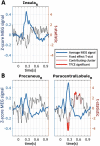Magnetoencephalographic correlates of mood and reward dynamics in human adolescents
- PMID: 34921602
- PMCID: PMC9340400
- DOI: 10.1093/cercor/bhab417
Magnetoencephalographic correlates of mood and reward dynamics in human adolescents
Abstract
Despite its omnipresence in everyday interactions and its importance for mental health, mood and its neuronal underpinnings are poorly understood. Computational models can help identify parameters affecting self-reported mood during mood induction tasks. Here, we test if computationally modeled dynamics of self-reported mood during monetary gambling can be used to identify trial-by-trial variations in neuronal activity. To this end, we shifted mood in healthy (N = 24) and depressed (N = 30) adolescents by delivering individually tailored reward prediction errors while recording magnetoencephalography (MEG) data. Following a pre-registered analysis, we hypothesize that the expectation component of mood would be predictive of beta-gamma oscillatory power (25-40 Hz). We also hypothesize that trial variations in the source localized responses to reward feedback would be predicted by mood and by its reward prediction error component. Through our multilevel statistical analysis, we found confirmatory evidence that beta-gamma power is positively related to reward expectation during mood shifts, with localized sources in the posterior cingulate cortex. We also confirmed reward prediction error to be predictive of trial-level variations in the response of the paracentral lobule. To our knowledge, this is the first study to harness computational models of mood to relate mood fluctuations to variations in neural oscillations with MEG.
Keywords: MEG; mood; reward prediction error; reward processing.
© The Author(s) 2021. Published by Oxford University Press. All rights reserved. For permissions, please e-mail: journals.permissions@oup.com.
Figures







References
-
- De Pascalis V, Strippoli E, Riccardi P, Vergari F. 2004. Personality, event-related potential (ERP) and heart rate (HR) in emotional word processing. Personal Individ Differ. 36:873–891. 10.1016/S0191-8869(03)00159-4. - DOI
Publication types
MeSH terms
Grants and funding
LinkOut - more resources
Full Text Sources
Medical

